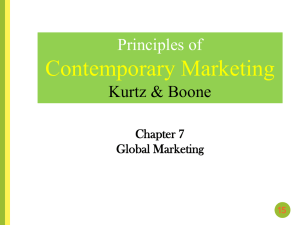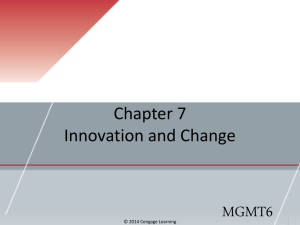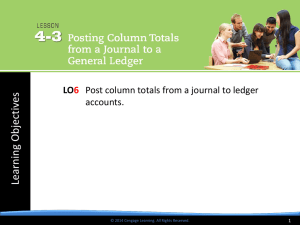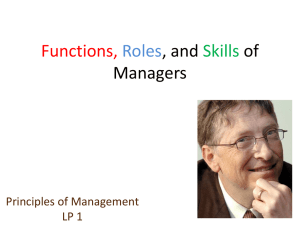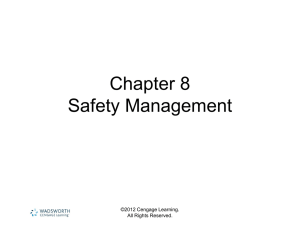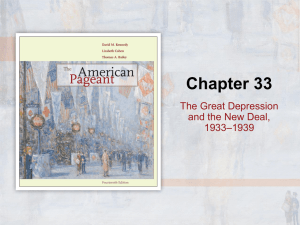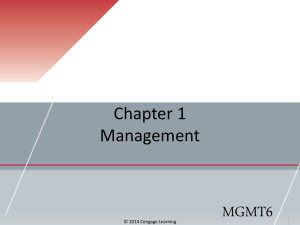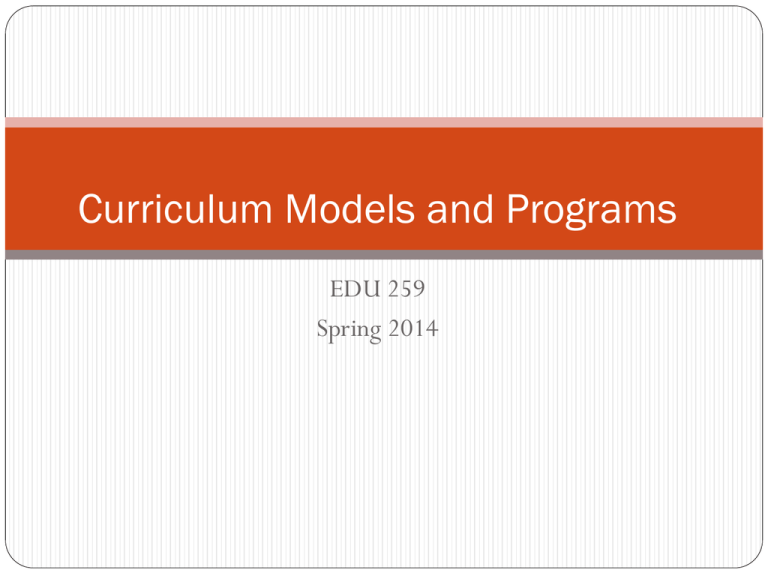
Curriculum Models and Programs
EDU 259
Spring 2014
Theories Influencing
Programs and Curricula
Collection of concepts and terms to predict
childhood development and behavior.
Numerous theories to explain and predict how
children behave and learn.
Level of influence is determined by schools and their
program philosophy.
Theories of Piaget and Vygotsky most widely used
today.
Copyright 2013 Wadsworth Cengage Learning.
All Rights Reserved.
Fundamental Principles
Early Childhood Education
Developmental practice to meet the needs of
each child.
Individual and age appropriate practice.
Family involvement and appreciation.
Authentic inclusion of children.
Observation and assessment of the children.
Professional accountability.
Copyright 2013 Wadsworth Cengage Learning.
All Rights Reserved.
Developmental Theorists
Erik Erikson –Psychosocial
Jean Piaget – Cognitive Development
Lev Vygotsky- Sociocultural
Howard Gardner – Multiple Intelligences
©2012 Cengage Learning.
All Rights Reserved.
Psychosocial Theory
Eight stages
First four stages most relevant to ECE
Trust versus mistrust
Autonomy versus shame and doubt
Initiative versus guilt
Industry versus inferiority
©2012 Cengage Learning.
All Rights Reserved.
Cognitive Theory
How young children learn
Constructivism
Assimilation
Schema/schemata
Accommodation
Equilibrium
Constructivism
Other terms
-object permanence, egocentric, symbolic thinking
©2012 Cengage Learning.
All Rights Reserved.
Cognitive Theory (continued)
Stages
Sensorimotor (birth to about 2 years)
Object permanence
Preoperational (about 2 to 7 years)
Egocentric
Concrete operations (7 to 12 years)
Formal operations (12 through adulthood)
©2012 Cengage Learning.
All Rights Reserved.
Sociocultural Theory
Learning is socially constructed
Zone of proximal development
Scaffolding
Teachers must be excellent observers
©2012 Cengage Learning.
All Rights Reserved.
Multiple Intelligences
one form of intelligence is not
•
•
•
better than another
individual differences in
children need to be taken very
seriously
cross-cultural exploration of
the ways individuals are
intelligent
Verbal linguistic and logicalmathematical intelligences are
well known and valued
All intelligences must be
addressed and celebrated
©2012 Cengage Learning.
All Rights Reserved.
Types of Intelligence:
1.
2.
3.
4.
5.
6.
7.
8.
Verbal-Linguistic Intelligence
Logical-Mathematical
Intelligence
Musical-Rhythmic Intelligence
Visual-Spatial Intelligence
Bodily-Kinesthetic Intelligence
Interpersonal Intelligence
Intrapersonal Intelligence
Naturalist Intelligence
Multiple Intelligences (continued)
This theory provides a framework for teachers to:
1. identify how children learn to build on their strongest
assets
2. help children become more intelligent by exposing them
to a variety of ways of learning
3. better individualize for children’s interests and needs
4. use teaching strategies that make learning more
appropriate, successful, and enjoyable for all children
©2012 Cengage Learning.
All Rights Reserved.
Learning Styles
Various legitimate methods of learning and processing
information
Sensory styles
Visual learner
Auditory learner
Tactile-kinesthetic learner
Field dependent learning style—able to grasp broad
distinctions among concepts and see relationships
through a social context
Field independent learning style—look at things
analytically, imposing one’s own structure to the task
©2011 Cengage Learning.
All Rights Reserved.
Play-Based Curriculum: The
Foundation for Learning
Play is foundation for learning
Children need meaningful materials
and activities in order to learn
Need to be physically, mentally, and
emotionally involved
©2011 Cengage Learning.
All Rights Reserved.
Play
Play is the core of developmentally appropriate practice
Play is the foundation for the curriculum
Threats to play
Teachers, administrators, policy-makers, and families
who do not understand the importance
Push-down of curricula expectations
Social and economic factors
Lack of time and opportunity
Electronic competition
©2012 Cengage Learning.
All Rights Reserved.
Parten’s Developmental Stages of Play
• Unoccupied behavior
• Onlooker play
• Solitary play
• Parallel play
• Associative play
• Cooperative play
©2012 Cengage Learning.
All Rights Reserved.
Types of Play
Types of Play
Theorists and Play
Erickson
Play helps develop cooperative relationships
Piaget
Practice play
Symbolic play
Games with rules
Lev Vygotsky
Social play helps child “interpret the world”
©2012 Cengage Learning.
All Rights Reserved.
Some Tips for Teachers
Play is neurological therefore is critical to
brain growth
Be aware of current research and resources
that validate the importance of play.
Create a positive place for play
Provide open-ended materials and activities
©2012 Cengage Learning.
All Rights Reserved.
Some Tips for Teachers
Introduce age-appropriate play activities and
materials
Provide time for play
Respect individual differences in play
Respect and provide for cultural diversity in
play
Observe children’s play and learn about
them
Play: Essential for All Children
Play enhances all developmental domains—
physical, social, cognitive, emotional, creative
Play inspires imagination, creativity,
exploration, self-confidence, more play
Play enhances problem solving, new skills, selfesteem, and sense of security
©2012 Cengage Learning.
All Rights Reserved.
Program Perspectives and Practices
1. Trends cycle and affect activities and
experiences.
2. Various programs:
Reggio Emilia Inspired
HighScope
Waldorf Schools,
Montessori
Creative Curriculum.
Copyright 2013 Wadsworth Cengage Learning.
All Rights Reserved.
Types of Programs
Some provide child care.
Some provide opportunities for learning.
Some provide both care and early learning.
Programs offer care and/or learning to infants and
toddlers, to preschoolers, and to school-age children
before and after school.
Copyright 2013 Wadsworth Cengage Learning.
All Rights Reserved.
Best Practices for Quality Programs
Are Developmentally Appropriate
Teachers who caringly and actively interact with
the children establish best practices
Sincere and meaningful relationships contribute
to forming an essential foundation for assuring
developmentally appropriate practice.
Developmentally appropriate curriculum
planning will support high-quality play
experiences while, at the same time, reinforce
children’s optimal skill development and
educational success.
Copyright 2013 Wadsworth Cengage Learning.
All Rights Reserved.
Practice Strengthening Connections: Harmony, Equity,
Respect in Children’s Programs
1. Programs follow
standards of quality
2. Responsive to
diversity of the
children, their families,
their communities
3. Strong connections
between the
children and
teachers
4. Curriculum
represents and
includes all children
realistically and
appropriate
Copyright 2013 Wadsworth Cengage Learning.
All Rights Reserved.
Curriculum Models and Programs
Head
Start
Bank
Street
Montessori
High/
Scope
©2012 Cengage Learning.
All Rights Reserved.
Reggio
Emilia
Montessori
“Absorbent minds”
Environment important
Hands-on activities
Involvement of family
Attitude of cooperation rather than competition
Self-correcting materials
Didactic materials
Focus on daily living tasks
Sensorial and conceptual materials
©2012 Cengage Learning.
All Rights Reserved.
Head Start
•
•
•
•
•
•
•
•
Publicly funded
Comprehensive services
Aimed at low-income, at-risk children and families
Low child-staff ratio
Written curriculum plan known as performance standards
Ten percent of enrollment available for children with special
needs
Involvement of families
Early Head Start to promote infant and toddler
development
©2012 Cengage Learning.
All Rights Reserved.
Bank Street
•
•
•
•
•
•
•
•
Founded by Lucy Sprague Mitchell
Child-centered learning
Emphasizes the interaction between the child and the
environment and interaction between the cognitive and affective
(developmental interaction)
Creation of meaning is the central task of childhood
Distinct learning centers
Opportunities for children to experience democratic living
Flexibility in the schedule
Synonymous with “open education”
©2012 Cengage Learning.
All Rights Reserved.
High/Scope
•
•
•
•
•
•
Created under the leadership of David Weikert
Began as an intervention program for low-income, atrisk children
High/Scope Perry Preschool Study
Active learning
Plan-do-review sequence
Emphasizes key experiences now known as key
developmental indicators (KDIs)
©2012 Cengage Learning.
All Rights Reserved.
Reggio Emilia
•
•
•
•
•
Founded by Loris Malaguzzi
Image of a strong child central to philosophy
Teachers are skilled observers
Pedigogista, atelierista, & The hundred languages of children
Principles are congruent with the principles of
developmentally appropriate practice
Environment is a “third teacher”
Relationships central in learning
©2012 Cengage Learning.
All Rights Reserved.
Curriculum Development
Themes and
units
Projects
Child
Webs
©2012 Cengage Learning.
All Rights Reserved.
Lesson
plans
Themes and Units
A theme is a broad concept or topic
A unit is a section of the curriculum
Basic concepts for developing thematic
curriculum
Merge play with child-directed and teacherinitiated experiences
Should be developmentally appropriate
Support a positive self-esteem
Activities should be adaptable
©2012 Cengage Learning.
All Rights Reserved.
Themes
Generally a smaller part of a unit, allowing for a
more specific focus
Those that directly concern children are generally
of greatest interest to the children
There is a danger of creating an artificial unit that
has no relevancy to the children’s experiences or
interests
Themes can be too restrictive and adult-directed
©2011 Cengage Learning.
All Rights Reserved.
Holiday Themes or Not?
Inappropriate to limit the use of themes to specific times
of the year or to celebrate holidays
Themes tend to isolate and narrowly define the topic
Some holiday themes may not be appropriate to every
family represented by the group
Tourist approach to cultural diversity: holiday themes are
often the only exposure the class has to a particular
culture
Overuse of holiday themes actually paints a flat picture
of a cultural or religious event without taking into
account how people in that culture live, work, sleep, or
play in ways that are similar to other children
©2011 Cengage Learning.
All Rights Reserved.
Life-Oriented Themes
Of great interest because they directly
concern themselves with young children
Teachers must know what reflects children’s
interest and abilities
Some themes address children’s own issues
Themes can be inclusive, integrated, and
appropriate
©2011 Cengage Learning.
All Rights Reserved.
Projects
A project is an in-depth investigation
- Addresses the four major learning goals of all education
Can be done by a small group, entire class, or individual child
Inquiry skills are utilized
Goes through 3 phases
1. Choose a topic
2. Investigate the topic
Co-learning
3. Review and reflect about what you have learned
©2012 Cengage Learning.
All Rights Reserved.
The Project Approach
Exploring a theme or topic over a period of days or
weeks
Children work in small groups throughout the process
and have the opportunity to make numerous choices
about their level of participation
Has different levels of complexity so it meets the needs
of children of different ages and abilities
Projects emerge from children’s own interests, the
teacher’s observations of children’s needs and interests,
and parents’ suggestions
©2011 Cengage Learning.
All Rights Reserved.
Process of Project Approach
The project approach: structural features
Discussion
Representation
Fieldwork
Investigation
Display
©2011 Cengage Learning.
All Rights Reserved.
Curriculum Webs
Graphic representation of brainstorming ideas
Integrate various learning activities
Develop the scope and content of the theme
Child-centered webbing can be used to create
activities that focus on the identified needs/goals
©2012 Cengage Learning.
All Rights Reserved.
Webbing
Webbing—the process through which a
teacher develops a diagram based on a
particular topic or theme, highlighting key
ideas and concepts
A planning tool that provides depth to a
topic and creates a map of possible activities
and projects
May be organized around a theme, into
curriculum areas, or around program goals
©2011 Cengage Learning.
All Rights Reserved.
Curriculum Web Developed for the book
Listen to the Wind
The Webbing Process
1. Brainstorming
2. Grouping
3. Sharing
4. Drawing
©2011 Cengage Learning.
All Rights Reserved.
Lesson and Activity Plans
Lesson plans involve making series of choices
Specific planning time
Planning form
“Things to remember” form/checklist
Activity plan
Step-by-step procedures
Writing measurable objectives
Key words
©2012 Cengage Learning.
All Rights Reserved.

